This post will teach you how to make new plants by cutting pieces off the parent plant. That way you can fill up your yard and also make plants to give away.
Look at this happy piece of rosemary:
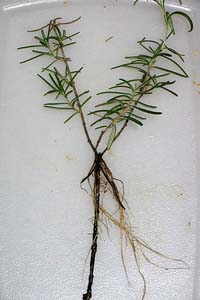
One little cutting from the original plant, treated right, makes a new plant! See those roots coming out of the node?
Making cuttings:
- Select your best plants. Each cutting will create an other plant which is genetically identical to the parent plant. So pick ones with the best flowers, or flavor or whatever. Some plants don’t work with cuttings (bulbs for example) or need other methods that I describe here. But this method covers most.
- Some people are picky about what time of the year to do cuttings, or believe that the cycle of the moon matters… That could be true, but I ignore that and have success.
- Cut pieces of that plant. Some people get very picky and say you have to use scalpel sharp knives and sterilize everything… I don’t worry that much and have great success. Some plants like you to take the new growth, and others the mature growth. A 45 degree angle seems good.
- Generally you want a nice clean cut though about 2cm below a “node”. Below a spot where the leaves come out while trying not to rip the plant’s skin off. That node is the spot which the new roots will come out of. Strip off the lower leaves since you will be putting that part in the ground and the leaves would rot. If the stem is long then you can cut the top and make more than one cutting from the same stalk. How you do different kinds of plants will vary, but often a piece about 6 inches long is good.
- For some plants it can be a good idea to dab a little paint on the top to seal it from drying out. That paint also helps you know which way it up! It may be that cutting the growing end off also makes the plant focus on growing new roots instead of continuing to grow upwards.
- Dab the bottom in Rooting hormone then tap most of it off. The hormone sends a signal to the plant to make roots. You can get away without using it in some cases. It is sold in a red cylindrical package at home gardening stores and (for locals) at the agricultural supply place on the libramiento in Pátzcuaro. There are other types as well. It is not organic, but well… it works. Women who might be pregnant should not get it on them… actually anybody should avoid skin contact, eye contact or breathing it.
- If you prefer, you can make a natural rooting hormone from the local willow trees. A web search will help you learn to do that.
- Let succulents (jade, aloe etc.) dry for a day or so before planting! They need to have the wound heal. Here is a tray of jade pieces waiting to heal before planting:
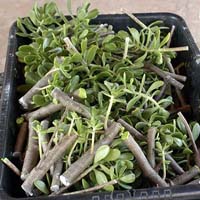
Notice the yellow paint on the tops. Cactus are the same as succulents in this regard though it depends on the species. Here are a bunch of large pitaya pieces growing roots:
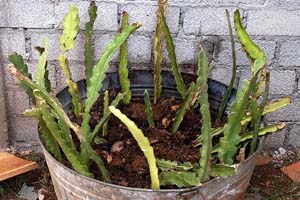
- Generally the softer the plant flesh the easier propagating with cuttings will be. Hardwoods can be impossible and there are other methods for those. (Lookup “Air Layering”)
- Remove many leaves from the cutting. The plant cannot support many leaves since it has no roots. Leave the younger leaves.
- Put the plant in a safe humid place away from much direct sun. You could put them directly in the ground, or in a pot, or a tray. Some people like to put the cuttings in water which does have the advantage of being able to see the roots showing up! You should use clean water though and you may have to change it often. Some people use peat moss and others care if the dirt is sterile…. I just use healthy dirt which I figure will be fine for the plants.
- One of the easiest ways to propagate is in plastic trays. They retain the moisture well. Try to let them almost dry out before adding more water though. If your cuttings rot, then there was too much water.
- Here are some mint cuttings, English ivy, and sage cuttings in a tray:
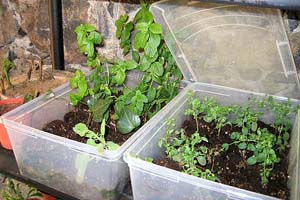
- Now you wait. Check on them occasionally. Each plant is a little different. Mist them if you like, but experiment with doing nothing. Doing nothing is easier.
- Even if the cuttings look dead, don’t give up on them. After a week or 6 weeks little leaves will sprout. If you get curious you can dig one up and see if there are roots, but you are likely to damage that one.
- Don’t worry if some die! Some plants are very very easy and others are nearly impossible. I have found geraniums, roses, rosemary, and many others to be very easy. All succulents seem easy. Bougainvilleas seem hard though I am having luck by using larger pieces that I was before. Start with easy plants so you get positive feedback! Try experimenting and you will find much success.
Direct-in-ground Cuttings:
This is my favorite way to do cuttings because I want to make tens of thousands of plants and don’t have city water or time to deal with them. At this time of the year in Michoacán you can pick a spot with good shade and dirt and stick your new cuttings directly in the ground! Pick a humid spot. If you do rows of them, then let them grow a year in that spot, and at the beginning of the rainy season next year you can dig the plants up and place them where you want. This is amazing since you never even had to water the plant or use a pot! You can go from one plant to having hundreds in a couple years at no cost and almost no work! My experiment from last year proved It works well, and this year I have about 30 times more garden space devoted to this method. Here is a photo of some datura, geraniums, and a medicinal herb cuttings which are about a year old and I will move to their new homes in June.
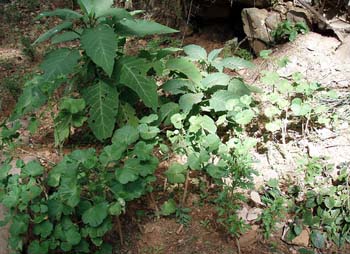
Here are some videos about plant cuttings: I am thinking I will make my own video sometime.
This video shows how to cut below a node
This video shows roots growing.
Here is the a fancy way. I consider this overkill.
http://www.youtube.com/watch?v=F7P8idtMluA
(By the way if videos play choppy, just hit “Pause” then do something else till the video loads further, then play.)
You will notice that people have many different ways of doing cuttings.
I have not had good success yet with bamboo. These never did develop roots and I tried a couple other ways too. I will try again.
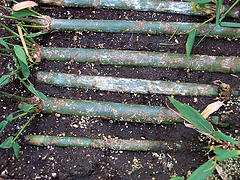
Here are some rosemary pieces in bottles, but generally I prefer to use dirt now. And those are pretty big pieces for rosemary.
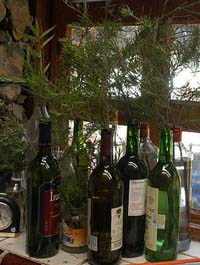
There is plenty of information on the web if you do a google search for cuttings and plant propagation. If you can’t find help with a question you have by searching on the web, we’d be happy to answer what questions we’re able.
Leave a Reply